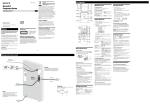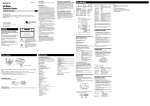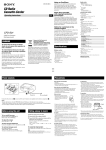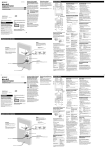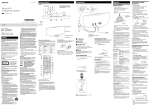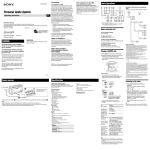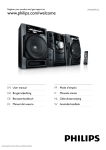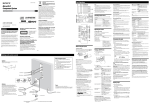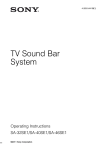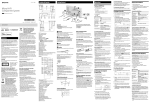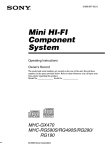Download Sony EH12LIV User's Manual
Transcript
2-639-099-15(1) Micro HI-FI Component System Operating Instructions GB This symbol is intended to alert the user to the presence of uninsulated “dangerous voltage” within the product’s enclosure that may be of sufficient magnitude to constitute a risk of electric shock to persons. This symbol is intended to alert the user to the presence of important operating and maintenance (servicing) instructions in the literature accompanying the appliance. Notice for customers: the following information is only applicable to equipment sold in countries applying EU Directives Owner’s Record The model and serial numbers are located on the rear of the unit. Record these numbers in the space provided below. Refer to them whenever you call upon your Sony dealer regarding this product. Model No. ______________ Serial No. ______________ CMT-EH10/EH12LIV © 2005 Sony Corporation Printed in China CAUTION WARNING The use of optical instruments with this product will increase eye hazard. To reduce the risk of fire or electric shock, do not expose this apparatus to rain or moisture. Except for customers in the U.S.A. and Canada This appliance is classified as a CLASS 1 LASER product. This marking is located on the rear exterior. To reduce the risk of fire, do not cover the ventilation of the apparatus with newspapers, tablecloths, curtains, etc. And do not place lighted candles on the apparatus. To reduce the risk of fire or electric shock, do not place objects filled with liquids, such as vases, on the apparatus. Connect the unit to an easily accessible AC outlet. Should you notice an abnormality in the unit, disconnect the main plug from the AC outlet immediately. For customers in the U.S.A. You are cautioned that any changes or modifications not expressly approved in this manual could void your authority to operate this equipment. Adjusting the sound The manufacturer of this product is Sony Corporation, 1-7-1 Konan, Minato-ku, Tokyo, 108-0075 Japan. The Authorized Representative for EMC and product safety is Sony Deutschland GmbH, Hedelfinger Strasse 61, 70327 Stuttgart, Germany. For any service or guarantee matters please refer to the addresses given in separate service or guarantee documents. To adjust the volume Press VOLUME +/– on the remote (or turn the VOLUME control on the unit) . To add a sound effect Disposal of Old Electrical & Electronic Equipment (Applicable in the European Union and other European countries with separate collection systems) WARNING This equipment has been tested and found to comply with the limits for a Class B digital device, pursuant to Part 15 of the FCC Rules. These limits are designed to provide reasonable protection against harmful interference in a residential installation. This equipment generates, uses, and can radiate radio frequency energy and, if not installed and used in accordance with the instructions, may cause harmful interference to radio communications. However, there is no guarantee that interference will not occur in a particular installation. If this equipment does cause harmful interference to radio or television reception, which can be determined by turning the equipment off and on, the user is encouraged to try to correct the interference by one or more of the following measures: – Reorient or relocate the receiving antenna. – Increase the separation between the equipment and receiver. – Connect the equipment into an outlet on a circuit different from that to which the receiver is connected. – Consult the dealer or an experienced radio/TV technician for help. This device complies with Part 15 of the FCC Rules. Operation is subject to the following two conditions: (1) This device may not cause harmful interference, and (2) this device must accept any interference received, including interference that may cause undesired operation. Basic Operations Press Generate a more dynamic sound (Dynamic Sound Generator X-tra) Set the sound effect DSGX on the unit. Playing a CD/MP3 disc Open the tape section lid. 1 Select the CD function. Press PUSH OPEN/CLOSE on the unit, and place a disc with the label side up on the CD compartment. To close the CD compartment, press PUSH OPEN/ CLOSE on the unit. PUSH OPEN/CLOSE U.S.A., Canadian and Australian models only ENERGY STAR is a U.S. registered mark. As an ENERGY STAR® partner, Sony Corporation has determined that this product meets the ENERGY STAR® guidelines for energy efficiency. ® 2 Insert a tape. Press (stop/eject) on the unit, and insert the tape into the cassette holder. Make sure there is no slack in the tape to avoid damaging the tape or the tape deck. 3 Start playback. Press (play) on the unit. To Press Pause playback (pause) on the unit. To resume play, press it again. Stop playback (stop/eject) on the unit. Rewind or fast forward* / on the unit. Do not turn off the system during playback or recording. Press (play) (or CD/ (play/pause) on the unit). MPEG Layer-3 audio coding technology and patents licensed from Fraunhofer IIS and Thomson. Find a location and an orientation that provide good reception, and then set up the antenna. Keep the antenna away from the speaker cords and the power cord to avoid picking up noise. Press To change Press Pause playback (pause) on the remote (or CD/ on the unit). To resume play, press it again. Information on the display1) DISPLAY repeatedly when the system is on. Stop playback (stop) . Display mode (Clock) DISPLAY when the system is off 2). The clock is displayed for eight seconds. Select a folder on an MP3 disc Select a track or file +/– . FM lead antenna (Extend it horizontally.) • With normal use, the batteries should last for about six months. • Do not mix an old battery with a new one or mix different types of batteries. • If you do not use the remote for a long period of time, remove the batteries to avoid damage from battery leakage and corrosion. To set the clock 1 Turn on the system. Press (power) . Connect the power cord to a wall socket. If the plug does not fit the wall socket, detach the supplied plug adaptor (only for models equipped with an adaptor). 2 Select the clock set mode. Press CLOCK/TIMER SET on the remote. If the current mode appears on the display, press / on the remote repeatedly to select “CLOCK,” and then press ENTER on the remote. 3 Set the time. AM loop antenna Press / on the remote repeatedly to set the hour, and then press ENTER on the remote. Use the same procedure to set the minutes. The clock settings are lost when you disconnect the power cord or if a power failure occurs. Insert only the stripped portion of the cord. Selecting a music source Solid (Red/) Press the following buttons (or press FUNCTION repeatedly). Left speaker To select Press CD CD on the remote. Tuner TUNER/BAND . Tape TAPE on the remote. Component* (connected using an audio cord) FUNCTION repeatedly until “AUDIO IN” appears. * If the component has the AVLS (Automatic Volume Limiter System) or BASS BOOST function, turn off the function to avoid distorted sound from the speakers. For example, you can view CD/MP3 disc information, such as the track or file number or folder name during normal play, or the total play time while the player is stopped. 2) The STANDBY indicator lights up when the system is turned off. 1) (go back/go forward) on the remote ( on the unit) . Find a point in a track or file Hold down / (rewind/fast forward) during playback, and release it at the desired point. Select Repeat Play REPEAT on the remote repeatedly until “REP” or “REP1” appears. Press PLAY MODE on the remote repeatedly while the player is stopped. You can select normal play (“ ” for all MP3 files in the folder on the disc), shuffle play (“SHUF” or “ SHUF*”), or program play (“PGM”). Notes on using the remote Changing the display To To change the play mode Antennas Wall socket Press FUNCTION repeatedly (or TAPE on the remote) . 3 Start playback. Hooking up the system securely Right speaker Use buttons on the unit for the operation. Note Slide and remove the battery compartment lid , and insert the two R6 (size AA) batteries (not supplied), side first, matching the polarities shown below. Solid (Black/) Playing a tape * Be sure to press (stop/eject) on the unit after the tape has been wound or rewound to the end. To use the remote For models with a voltage selector, set VOLTAGE SELECTOR to the local power line voltage. Press FM MODE on the remote repeatedly until “MONO” appears to turn off stereo reception. 2 Place a disc. Before using the system Power To reduce static noise on a weak FM stereo station Press CD on the remote (or FUNCTION repeatedly) . Excessive sound pressure from earphones and headphones can cause hearing loss. Do not expose batteries or apparatus with batteryinstalled to excessive heat such as sunshine, fire or the like. EQ on the remote. Press TUNING MODE on the remote repeatedly until “MANUAL” appears, and then press +/– on the remote repeatedly (or TUNING + or – on the unit) to tune in the desired station. 1 Select a tape function. This symbol on the product or on its packaging indicates that this product shall not be treated as household waste. Instead it shall be handed over to the applicable collection point for the recycling of electrical and electronic equipment. By ensuring this product is disposed of correctly, you will help prevent potential negative consequences for the environment and human health, which could otherwise be caused by inappropriate waste handling of this product. The recycling of materials will help to conserve natural resources. For more detailed information about recycling of this product, please contact your local Civic Office, your household waste disposal service or the shop where you purchased the product. Applicable accessories: Remote commander European model only Do not install the appliance in a confined space, such as a bookcase or built-in cabinet. To To tune in a station with a weak signal * When playing a CD-DA disc, operation as SHUF Play. Notes on the display information • The following are not displayed; – total playing time for a CD-DA disc depending on the play mode. – total playing time for an MP3 disc. – remaining playing time for a track and an MP3 file. • The following are not displayed correctly; – elapsed playing time of an MP3 file encoded using a VBR (variable bit rate). – folder and file names that do not follow either the ISO9660 Level 1, Level 2 or Joliet in the expansion format. • The following are displayed; – ID3 tag information for MP3 files when ID3 version 1 and version 2 tags are used. – up to 15 characters of ID3 tag information using uppercase letters (A to Z), numbers (0 to 9), and symbols (‘< > * + , – / @ [ \ ] _). (SHUF) Play performs the same • All tracks or files on a disc are played repeatedly up to five times. • “REP1” indicates that a single track or file is repeated until you stop it. Using optional audio components Notes on playing MP3 discs To connect an optional headphones Notes on Repeat Play • Do not save other types of tracks or files or unnecessary folders on a disc that has MP3 files. • Folders that have no MP3 files are skipped. • MP3 files are played back in the order that they are recorded onto the disc. • The system can only play MP3 files that have a file extension of “.MP3”. • If there are files on the disc that have the “.MP3” file extension, but that are not MP3 files, the unit may produce noise or may malfunction. • The maximum number of: – folders is 150 (including the root folder). – MP3 files is 255. – MP3 files and folders that can be contained on a single disc is 256. – folder levels (the tree structure of files) is eight. • Compatibility with all MP3 encoding/writing software, recording device, and recording media cannot be guaranteed. Incompatible MP3 discs may produce noise or interrupted audio or may not play at all. Notes on playing multisession discs • If the disc begins with a CD-DA (or MP3) session, it is recognized as a CD-DA (or MP3) disc, and playback continues until another session is encountered. • A disc with a mixed CD format is recognized as a CD-DA (audio) disc. Listening to the radio 1 Select “FM” or “AM.” Press TUNER/BAND repeatedly. 2 Select the tuning mode. Press TUNING MODE on the remote repeatedly until “AUTO” appears. 3 Tune in the desired station. Press +/– on the remote (or TUNING + or – on the unit) . Scanning stops automatically when a station is tuned in. When you tune in a station that provides RDS services, the station name appears on the display. Tip To stop automatic scanning, press (stop) . Connect headphones to the PHONES jack on the unit. To connect an optional component Connect additional audio source component to the AUDIO IN jack on the unit using an audio analog cord (not supplied). Turn down the volume on the system, and then select the AUDIO IN function. Troubleshooting Other Operations Creating your own CD program Recording onto a tape (Program Play) Use a TYPE I (normal) tape only. Use buttons on the remote to create your own program. You can record just the portions you like from a sound source, including connected audio components. 1 Press CD to select the CD function. 2 Press PLAY MODE repeatedly until “PGM” appears while the player is stopped. 3 Press / (or on the unit) repeatedly until the desired track number appears. When programing MP3 files, press +/– repeatedly to select the desired folder, and then select the desired file. Selected track or file number 4 Press ENTER to add the track or file to the program. 5 Repeat steps 3 through 4 to program additional tracks or files, up to a total of 15 tracks or files. 6 To play your program of tracks or files, press (or CD/ on the unit). The program remains available until you open the CD compartment. To play it again, select the CD function, and press (or CD/ on the unit). Use buttons on the unit to control tape recording. 1 Insert a recordable tape into the cassette holder with the side you want to record facing forward. 2 Prepare the recording source. Select the desired source to record. Place the disc you want to record. When recording a folder from an MP3 disc, press PLAY MODE on the remote repeatedly to select “ ,” and then press +/– repeatedly to select the desired folder. To record only your favorite CD tracks or MP3 files in your desired order, perform steps 2 to 5 of “Creating your own CD program.” 3 Start recording. Press (record) , and then start playing the desired recording source. The CD starts playing automatically. If there is noise while recording from the tuner, reposition the appropriate antenna to reduce the noise. While recording, you cannot listen to other sources. To stop recording, press . Tip To cancel Program Play, press PLAY MODE repeatedly until “PGM” disappears while the player is stopped. We recommend that you press first, and then press to avoid noise being recorded when you stop recording. To delete the last track or file of the program, press CLEAR on the remote while the player is stopped. Using the Timers To view program information, such as total track number of the program, press DISPLAY repeatedly. The system offers two timer functions. If you use both timers, the Sleep Timer has priority. You can preset your favorite radio stations and tune them in instantly by selecting the corresponding preset number. Use buttons on the remote to preset stations. 1 Press TUNER/BAND repeatedly to select “FM” or “AM.” 2 Press TUNING MODE repeatedly until “AUTO” appears (or “MANUAL” appears, for a station with a weak signal). 3 Press +/– (or TUNING + or – on the unit) to tune in the desired station. Scanning stops automatically when a station is tuned in, and then “TUNED” and “STEREO” (for stereo programs) appear. 4 Press TUNER MEMORY on the remote. Preset number You can preset up to 20 FM and 10 AM stations. The preset stations are retained for about half a day even if you disconnect the power cord or if a power failure occurs. 8 To call up a preset radio station, press TUNING MODE repeatedly until “PRESET” appears, and then press +/– (or TUNING + or – on the unit) repeatedly to select the desired preset number. To change the AM tuning interval from the factory preset to 9 kHz (or 10 kHz, for some areas; this function is not available on the European model), tune in any AM station, and then turn off the system. Press DISPLAY to display the clock and while hold down TUNING + on the unit, press on the unit. All the AM preset stations are erased. To reset the interval to the factory preset, repeat the procedure. Immediately unplug the power cord, and check the following item. • If your system has a voltage selector, is the voltage selector set to the correct voltage? After the STANDBY indicator stops flashing, reconnect the power cord, and turn on the system. If the issue persists, contact your nearest Sony dealer. General The system unexpectedly shuts off while operating. • Are the + and – speaker cords short-circuited? Make sure the speaker cords are correctly connected. There is no sound. • Are the + and – speaker cords short-circuited? • Connect only the supplied speakers. • Do not obstruct the ventilation holes. Sound comes from one channel, or the left and right volumes are unbalanced. • Place the speakers as symmetrically as possible. • Connect only the supplied speakers. • Move the system away from sources of noise. • Connect the system to a different wall socket. • Install a noise filter (available separately) to the power cord. You can wake up to CD or tuner at a preset time. Use buttons on the remote to control the Play Timer. Make sure you have set the clock. 1 Prepare the sound source. Prepare the sound source, and then press VOLUME +/– (or turn the VOLUME control on the unit) to adjust the volume. To start from a specific CD track or MP3 file, create your own CD program. and then press ENTER . “ON TIME” appears, and the hour indication flashes. 4 Set the time to start playing. Press / repeatedly to set the hour, and then press ENTER . The minute indication flashes. Use the procedure above to set the minute. Press / repeatedly until the desired sound source appears, and then press ENTER . The display shows the timer settings. 7 Press to turn off the system. If the system is on at the preset time, the Play Timer will not play. To activate or check the timer again, press CLOCK/ TIMER SELECT , press / repeatedly until “PLAY” appears, and then press ENTER . To cancel a timer, repeat the same procedure as above until “OFF” appears, and then press ENTER . To change the setting, start over from step1. Tip The Play Timer setting remains as long as the setting is not canceled manually. If the system still does not operate properly, reset the system to factory settings. Use buttons on the unit to reset the unit to its factory default settings. 1 Disconnect and reconnect the power cord, and then turn on the system. 2 Press , DSGX , and at the same time. All user-configured settings, such as preset radio stations, timer, and the clock, are deleted. Messages COMPLETE : The preset operation ended normally. FULL : You tried to program more than 15 tracks (steps). NO DISC : There is no disc in the player, or you have loaded a disc that cannot be played. NO STEP : All of the programed tracks have been erased. NOT USED : You pressed an invalid button. OVER : You have reached the end of the disc while pressing during playback or pause. PUSH SELECT : You tried to set the clock or timer during timer operation. PUSH STOP : You pressed PLAY MODE during playback. READING : The system is reading information from the disc. Some buttons are not available. SET CLOCK : You tried to select the timer when the clock is not set. SET TIMER : You tried to select the timer when the Play Timer is not set. TIME NG : The Play Timer start and end times are set to the same time. Display examples Display The remote does not function. The sound skips, or the disc will not play. 6 Select the sound source. 6 Press ENTER . 7 Repeat steps 1 through 6 to store other stations. If the STANDBY indicator flashes Play Timer: time to stop playing. repeatedly to select your desired preset number. If another station is already assigned to the selected preset number, the station is replaced by the new stations. take the indicated corrective action. If the issue persists, contact your nearest Sony dealer. • Remove any obstacles between the remote and the remote sensor on the unit, and position the unit away from fluorescent lights. • Point the remote at the system’s sensor. • Move the remote closer to the system. 5 Use the same procedure as in step 4 to set the 5 Press +/– (or TUNING + or – on the unit) 2 Find your problem in the checklist below, and You can fall asleep to music. This function works even if the clock is not set. Press SLEEP on the remote repeatedly. If you select “AUTO,” the system automatically turns off after the current disc or tape stops or in 100 minutes. If the tape deck is still playing or recording at the set time, the system turns off after the tape deck stops. 2 Press CLOCK/TIMER SET . 3 Press / repeatedly to select “PLAY,” If “TUNED” does not appear and the scanning does not stop, press TUNING MODE until “MANUAL” appears and press +/– (or TUNING + or – on the unit) repeatedly to tune in the desired station. correctly and firmly connected. Severe hum or noise. Sleep Timer: Presetting radio stations 1 Make sure the power cord and speaker cords are To reset the system to factory settings indicates 2 (two) 6 (six) 8 (eight) A B CD/MP3 player D G • Wipe the disc clean, and replace it. • Move the system to a location away from vibration (for example, on top of a stable stand). • Move the speakers away from the system, or place them on separate stands. At high volume, speaker vibration may cause the sound to skip. H K M O or 0 (zero) Play does not start from the first track. Q • Return to Normal Play by pressing PLAY MODE repeatedly until both “PGM” and “SHUF” disappear. R Starting playback takes more time than usual. S or 5 (five) • The following discs take a longer time to start playback. – a disc recorded with a complicated tree structure. – a disc recorded in multisession mode. – a disc that has not been finalized (a disc to which data can be added). – a disc that has many folders. Z Tuner Severe hum or noise, or stations cannot be received. (“TUNED” or “STEREO” flashes on the display.) • Connect the antenna properly. • Find a location and an orientation that provide good reception, and then set up the antenna again. • Keep the antenna away from the speaker cords and the power cord to avoid picking up noise. • Turn off nearby electrical equipment. Tape deck The sound exhibits excessive wow or flutter or dropout. • Clean the capstans and pinch rollers. Also, clean and demagnetize the tape heads. See “Precautions” for details. To improve tuner reception Turn off CD player power by using the CD power management function. By default, CD power is turned on. Use buttons on the unit to turn off CD player power. 1 Press CD on the remote (or FUNCTION repeatedly) to select the CD function. 2 Press to turn off the system. 3 After “STANDBY” stops flashing, press DISPLAY to display the clock and then press while holding down on the unit. “CD POWER OFF” appears. With CD player power turned off, disc access time is increased. To turn on CD player power, repeat the procedure until “CD POWER ON” appears. , @ Precautions Discs that this system CAN play Note on DualDiscs A DualDisc is a two sided disc product which mates DVD recorded material on one side with digital audio material on the other side. However, since the audio material side does not conform to the Compact Disc (CD) standard, playback on this product is not guaranteed. Music discs encoded with copyright protection technologies This product is designed to playback discs that conform to the Compact Disc (CD) standard. Recently, various music discs encoded with copyright protection technologies are marketed by some record companies. Please be aware that among those discs, there are some that do not conform to the CD standard and may not be playable by this product. On safety • The unit is not disconnected from the AC power source (mains) as long as it is connected to the wall socket, even if the unit itself has been turned off. • Completely disconnect the power cord (mains lead) from the wall socket (mains) if it is not going to be used for an extended period of time. When unplugging the unit, always grip the plug. Never pull the cord itself. • Should any solid object or liquid get into the system, unplug the system, and have it checked by qualified personnel before operating it again. • The AC power cord can be changed only by a qualified service facility. On placement • Do not place the system in an inclined position or in locations that are extremely hot, cold, dusty, dirty, or humid or lacking adequate ventilation, or subject to vibration, direct sunlight or a bright light. • Be careful when placing the unit or speakers on surfaces that have been specially treated (for example, with wax, oil, polish) as staining or discoloration of the surface may result. • If the system is brought directly from a cold to a warm location or is placed in a very damp room, moisture may condense on the lens inside the CD player, and cause the system to malfunction. In this situation, remove the disc, and leave the system turned on for about an hour until the moisture evaporates. On heat buildup • Heat buildup on the unit during operation is normal and is not cause for alarm. • Do not touch the cabinet if it has been used continuously at a high volume because the cabinet may have become hot. • Do not obstruct the ventilation holes. On the speaker system This speaker system is not magnetically shielded, and the picture on nearby TV sets may become magnetically distorted. In this situation, turn off the TV, wait 15 to 30 minutes, and turn it back on. If there is no improvement, move the speakers far away from the TV. Cleaning the cabinet Clean this system with a soft cloth slightly moistened with a mild detergent solution. Do not use any type of abrasive pad, scouring powder, or solvent, such as thinner, benzine, or alcohol. To prevent a tape from being accidentally recorded over Break off the cassette’s overwrite protection tab from side A or B as illustrated. Break off the cassette tab • Audio CD • CD-R/CD-RW (audio data/MP3 files) Discs that this system CANNOT play • CD-ROM • CD-R/CD-RW other than those recorded in music CD format or MP3 format conforming to ISO9660 Level 1/Level 2, Joliet or multisession • CD-R/CD-RW recorded in multisession that have not ended by “closing the session” • CD-R/CD-RW of poor recording quality, CD-R/CDRW that have scratches or are dirty, or CD-R/CD-RW recorded with an incompatible recording device • CD-R/CD-RW which is finalized incorrectly • Discs containing files other than MPEG 1 Audio Layer3 (MP3) files • Discs of non-standard shape (for example, heart, square, star) • Some discs that have adhesive tape, paper, or sticker attached to them • Some rental or used discs with attached seals where the glue extends beyond the seal • Some discs that have labels printed using ink that feels tacky when touched Notes on discs • Before playing, wipe the disc with a cleaning cloth from the center out to the edge. • Do not clean discs with solvents, such as benzine thinner, or commercially available cleaners or antistatic spray intended for vinyl LPs. • Do not expose discs to direct sunlight or heat sources such as hot air ducts, nor leave it in a car parked in direct sunlight. To later reuse the tape for recording, cover the broken tab with adhesive tape. About a tape longer than 90 minutes The use of the tape with more than 90 minutes of play time is not recommended except for long, continuous recording or playback. Cleaning the tape heads Use dry- or wet-type cleaning cassette (available separately) after every 10 hours of use, before you start an important recording, or after playing an old tape. Failure to clean the tape heads can cause degraded sound quality or an inability of the unit to record or play tapes. For details, refer to the instructions of the cleaning cassette. Demagnetizing the tape heads Use a demagnetizing cassette (available separately) after every 20 to 30 hours of use. Failure to demagnetize the tape heads can cause an increase in noise, a loss of high frequency sound, and an inability to completely erase tapes. For details, refer to the instructions of the demagnetizing cassette. Specifications Main unit AUDIO POWER SPECIFICATIONS POWER OUTPUT AND TOTAL HARMONIC DISTORTION: (The United States model only) With 4 ohm loads, both channels driven, from 100 – 20,000 Hz; rated 4 watts per channel minimum RMS power, with no more than 10% total harmonic distortion from 250 milliwatts to rated output. Amplifier section North-American model: Continuous RMS power output (reference): 5 + 5 W (4 ohms at 1 kHz, 10% THD) European model: DIN power output (rated): 4 + 4 W (4 ohms at 1 kHz, DIN) Continuous RMS power output (reference): 5 + 5 W (4 ohms at 1 kHz, 10% THD) Music power output (reference): 7 + 7 W The following are measured at AC 240 V, 50/60 Hz (Australian model), AC 220 V, 60 Hz (Korean model), AC 220 V, 50/60 Hz (Argentine and Chinese models), AC 120 V, 50/60 Hz (Taiwanese model), AC 120 or 240 V, 50/60 Hz (other models) DIN power output (rated): 4 + 4 W (4 ohms at 1 kHz, DIN) Continuous RMS power output (reference): 5 + 5 W (4 ohms at 1 kHz, 10% THD) Inputs AUDIO IN (stereo mini jack): Sensitivity 800 mV, impedance 47 kilohms Outputs PHONES (stereo mini jack): Accepts headphones with an impedance of 8 ohms or more SPEAKER: Accepts impedance of 4 ohms CD player section System: Compact disc and digital audio system Laser Diode Properties Emission duration: continuous Laser Output*: Less than 44.6µW * This output is the value measurement at a distance of 200mm from the objective lens surface on the Optical Pick-up Block with 7mm aperture. Frequency response: 20 Hz – 20 kHz Signal-to-noise ratio: More than 90 dB Dynamic range: More than 90 dB Tape deck section Recording system: 4-track 2-channel, stereo Tuner section FM stereo, FM/AM superheterodyne tuner Antenna: FM lead antenna AM loop antenna FM tuner section: Tuning range North American model: 87.5 – 108.0 MHz (100 kHz step) Other models: 87.5 – 108.0 MHz (50 kHz step) Intermediate frequency: 10.7 MHz AM tuner section: Tuning range North American models: 530 – 1,710 kHz (with 10 kHz tuning interval) 531 – 1,710 kHz (with 9 kHz tuning interval) European model: 531 – 1,602 kHz (with 9 kHz tuning interval) Other models: 530 – 1,710 kHz (with 10 kHz tuning interval) 531 – 1,602 kHz (with 9 kHz tuning interval) Intermediate frequency: 450 kHz Speaker Speaker system: Full Range, 8 cm dia., cone type Nominal impedance: 4 ohms Dimensions (w/h/d): Approx. 145 × 241.5 × 134 mm Mass: Approx. 1.4 kg net per speaker General Power requirements North American model: AC 120 V, 60 Hz European model: AC 230 V, 50/60 Hz Australian model: AC 230 – 240 V, 50/60 Hz Korean model: AC 220 V, 60 Hz Argentine and Chinese models: AC 220 V, 50/60 Hz Taiwanese model: AC 120 V, 50/60 Hz Other models: AC 110 – 120 or 220 – 240 V, 50/60 Hz Adjustable with voltage selector Power consumption: North American model: 23 W European model: 22 W 1.0 W (in Power off) Other models: 22 W Dimensions (w/h/d) (excl. speakers): Approx. 158 × 241.5 × 233 mm Mass (excl. speakers): Approx. 2.1 kg Supplied accessories: Remote Commander (1)/FM/AM antenna (1) Design and specifications are subject to change without notice. • Standby power consumption: 1.0 W • Halogenated flame retardants are not used in the certain printed wiring boards. • Halogenated flame retardants are not used in cabinets. (Except for the United States model)



